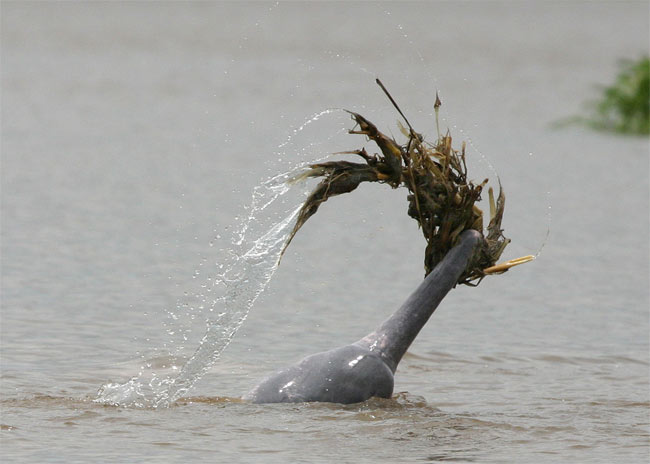Dolphin Bling Gets Girls

Just as men can use fast cars or showy clothes to impress the ladies, so too do male Amazon river dolphins show off stuff to woo the opposite sex.
Among these dolphins, the attention-getter is a male carrying a branch or similar flotsam in its mouth. Such "player" behavior is a first to be documented in aquatic mammals and, among land mammals, it has previously been seen only in chimpanzees and humans, researchers said.
These new findings help show that humans are "not as different from other animals as some might like to think," said researcher Anthony Martin, a behavioral ecologist and population biologist at the University of St. Andrews in Scotland.
Amazon river dolphins, also known as botos or pink river dolphins (Inia geoffrensis), live mostly off fish in the Amazon River basin, with the occasional turtle or crab.
The botos had often seemed to play with items such as sticks or lumps of hard clay, thrashing them against the surface of the water or tossing them with flicks of their heads.
One day scientists noticed that three botos that held objects in their mouths were all adult males. This prompted speculation that such behavior might not be play at all.
Martin and his colleagues carried out hundreds of subsequent observations of dolphins. Trying to live and work in the flooded Amazon forest was challenging, with investigators having to overcome things "like the heat and humidity, which destroys electronic equipment; opacity of the water, which is like milk coffee, you can't see underwater; and the insects and fungi that busily turn our floating lab home into mush," he said.
Get the world’s most fascinating discoveries delivered straight to your inbox.
Martin and his colleagues found the overwhelming majority of those who carried items were adult males, which are larger and pinker than females.
"It's particularly interesting that the complexity of this behavior in these dolphins is considerably greater than that in chimps," Martin said. "Chimp males break off branches, thrash them around and make a lot of noise to show off how macho they are — bit like blokes with big motorbikes and Ferraris, I guess. Botos, however, are much more subtle, and often use their objects in what appears to be a ritualistic way."
Males typically held objects when there were adult females present.
"This species has a mythical reputation for enchanting and seducing women in Amazon communities, and you could believe that they really are enchanting their own females with this object-carrying behavior," Martin said.
Aggression among males — such as biting or striking another dolphin with the head or tail — was strongly linked with object-carrying, and perhaps was linked to access to females, the scientists added.
Although the scientists think they saw some females carry objects, "it's possible some of these 'females' were actually pre-adult males, because some such males are the same size and color as some adult females," Martin said. Even if these were females, "the number of examples of females carrying objects was tiny, and in any animal population you can expect to find some individuals who do things different."
Martin noted this behavior was found in populations of botos that have probably been geographically isolated from each other for millions of years.
"It is therefore either ancestral to them all and therefore millions of years old or has evolved independently in each case," Martin said. "Either way it does appear to be deep-rooted in their behavior and passed from one generation to the next. Some would argue that this is culture."
Martin noted that "river dolphins are the most endangered and least understood of all cetaceans, and we are in a race to find out how to conserve them before they all disappear."
Martin and his colleagues Vera da Silva and Peter Rothery detailed their findings online March 26 in the journal Biology Letters.
- Top 10 Amazing Animal Abilities
- Image Gallery: Life Under the Sea
- How Dolphins Spin, and Why

 Live Science Plus
Live Science Plus





